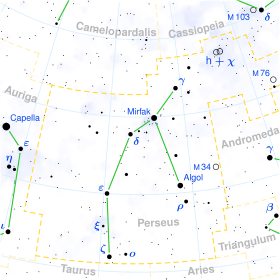1 Aurigae
| Observation data Epoch J2000 Equinox J2000 | |
|---|---|
| Constellation | Perseus |
| Right ascension | 04h 49m 54.63946s[1] |
| Declination | 37° 29′ 17.7936″[1] |
| Apparent magnitude (V) | 4.89[2] |
| Characteristics | |
| Spectral type | K3.5IIIBa0.2:[3] |
| U−B color index | +1.71[4] |
| B−V color index | +1.45[4] |
| Astrometry | |
| Radial velocity (Rv) | -24.65[5] km/s |
| Proper motion (μ) | RA: -36.89[1] mas/yr Dec.: +38.85[1] mas/yr |
| Parallax (π) | 6.48 ± 0.44[1] mas |
| Distance | 500 ± 30 ly (150 ± 10 pc) |
| Absolute magnitude (MV) | -1.04[2] |
| Details | |
| Luminosity | 561[2] L☉ |
| Surface gravity (log g) | 1.12[6] cgs |
| Temperature | 4,102[6] K |
| Metallicity [Fe/H] | -0.30[6] dex |
| Rotational velocity (v sin i) | 1.6[7] km/s |
| Other designations | |
| Database references | |
| SIMBAD | data |
1 Aurigae is the original name for a star now in the constellation Perseus. It was the first entry in John Flamsteed's catalogue of stars in Auriga. When Eugène Joseph Delporte drew up simplified boundaries for the constellations on behalf of the International Astronomical Union in 1930, 1 Aurigae ended up over the border in Perseus. To avoid confusion, the star is now generally known by its Harvard Revised catalogue number, HR 1533.
It is an orange K-type giant with an apparent magnitude of +4.88 and lies approximately 520 light years from Earth.
References
- 1 2 3 4 5 Van Leeuwen, F. (2007). "Validation of the new Hipparcos reduction". Astronomy and Astrophysics. 474 (2): 653. arXiv:0708.1752. Bibcode:2007A&A...474..653V. doi:10.1051/0004-6361:20078357. Vizier catalog entry
- 1 2 3 Anderson, E.; Francis, Ch. (2012). "XHIP: An extended hipparcos compilation". Astronomy Letters. 38 (5): 331. arXiv:1108.4971. Bibcode:2012AstL...38..331A. doi:10.1134/S1063773712050015. Vizier catalog entry
- ↑ Hoffleit, D.; Warren, W. H. (1995). "VizieR Online Data Catalog: Bright Star Catalogue, 5th Revised Ed. (Hoffleit+, 1991)". VizieR On-line Data Catalog: V/50. Originally published in: 1964BS....C......0H. 5050. Bibcode:1995yCat.5050....0H.
- 1 2 Mermilliod, J. C. (2006). "VizieR Online Data Catalog: Homogeneous Means in the UBV System (Mermilliod 1991)". VizieR On-line Data Catalog: II/168. Originally published in: Institut d'Astronomie. 2168. Bibcode:2006yCat.2168....0M. Vizier catalog entry
- ↑ Famaey, B.; Jorissen, A.; Luri, X.; Mayor, M.; Udry, S.; Dejonghe, H.; Turon, C. (2005). "Local kinematics of K and M giants from CORAVEL/Hipparcos/Tycho-2 data". Astronomy & Astrophysics. 430: 165. arXiv:astro-ph/0409579. Bibcode:2005A&A...430..165F. doi:10.1051/0004-6361:20041272.
- 1 2 3 Earle Luck, R. (2014). "Parameters and Abundances in Luminous Stars". The Astronomical Journal. 147 (6): 137. Bibcode:2014AJ....147..137L. doi:10.1088/0004-6256/147/6/137.
- ↑ De Medeiros, J. R.; Mayor, M. (1999). "A catalog of rotational and radial velocities for evolved stars". Astronomy and Astrophysics Supplement Series. 139 (3): 433. arXiv:astro-ph/0608248. Bibcode:1999A&AS..139..433D. doi:10.1051/aas:1999401. Vizier catalog entry
This article is issued from
Wikipedia.
The text is licensed under Creative Commons - Attribution - Sharealike.
Additional terms may apply for the media files.
